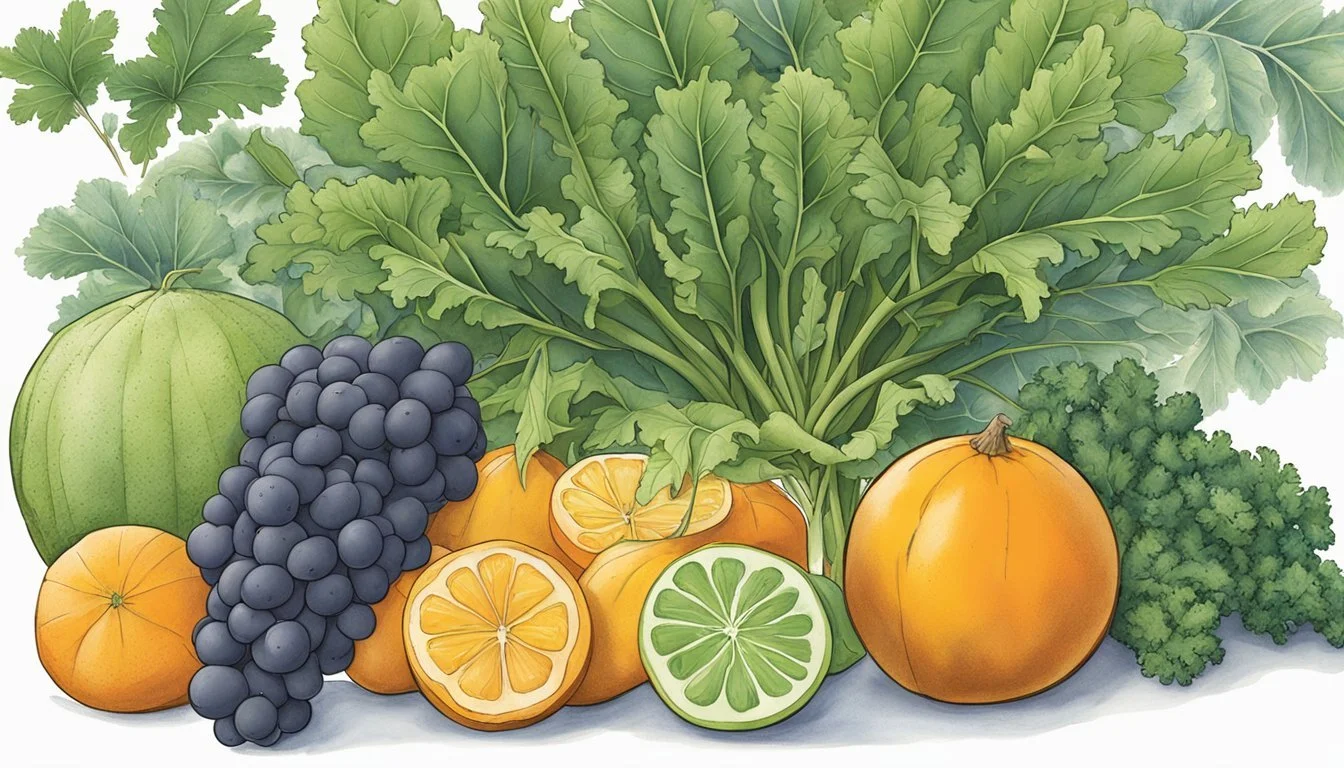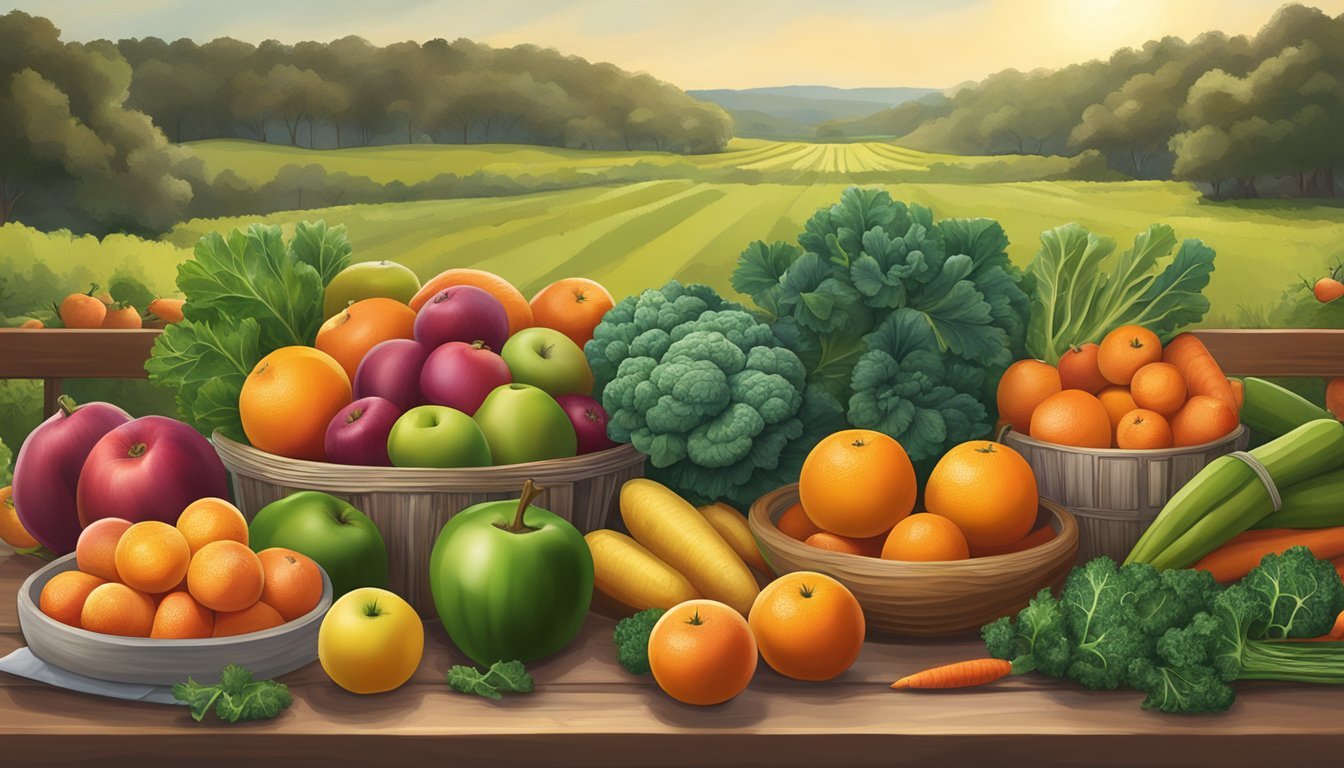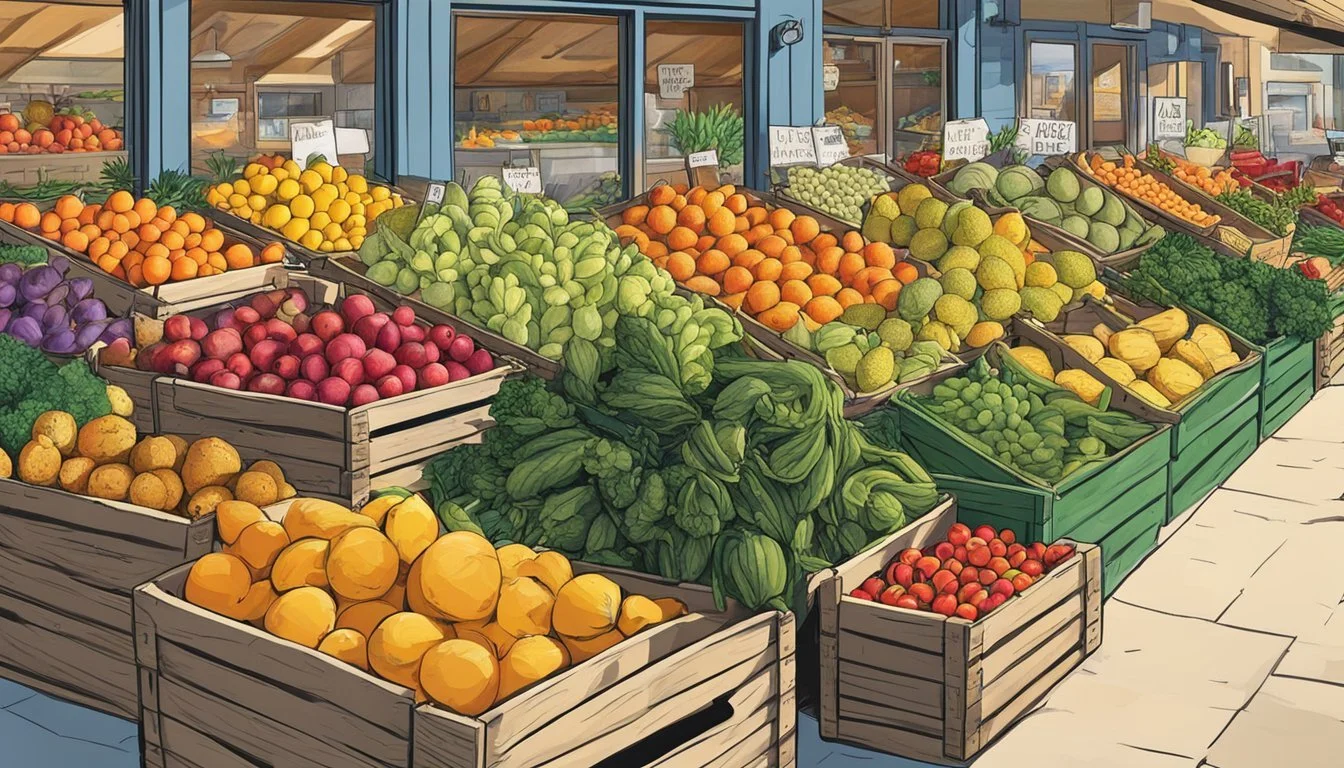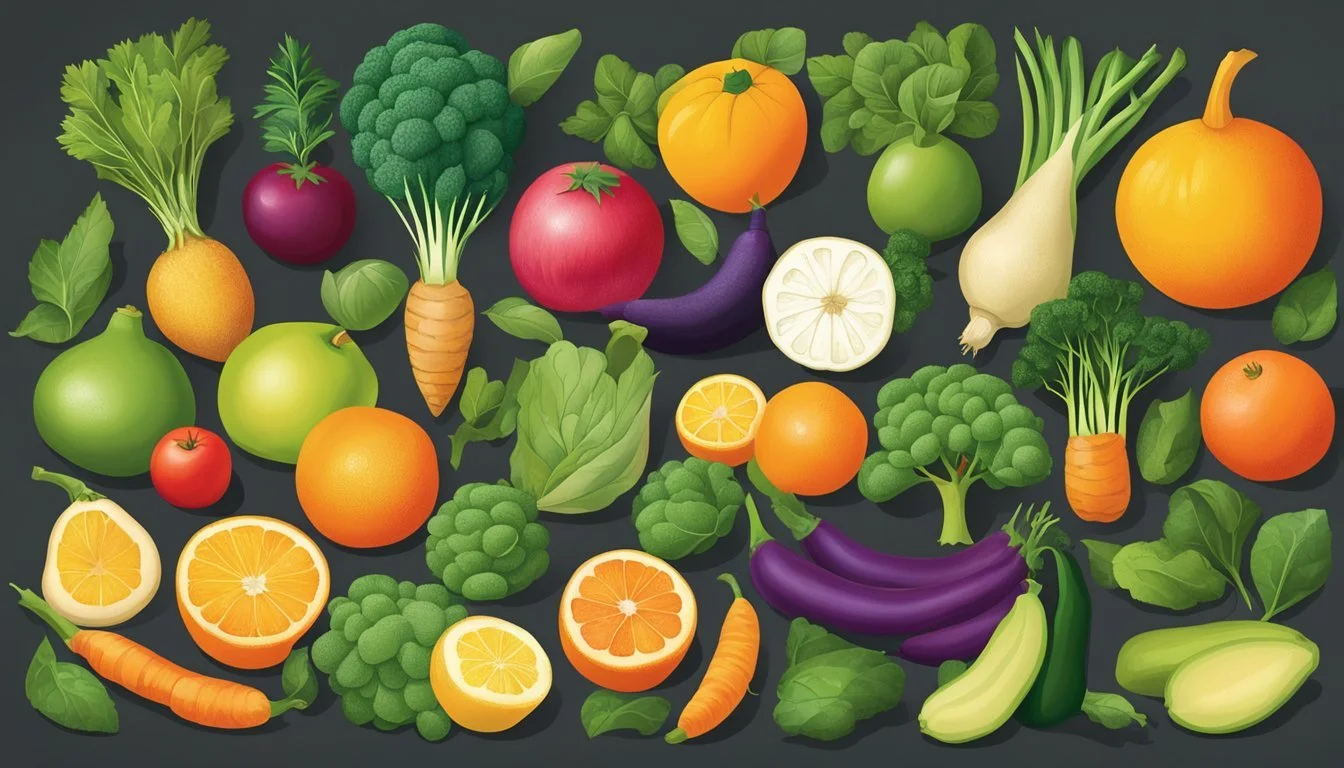South Carolina Seasonal Fruit & Vegetables in January
A Guide to Winter Produce Selection
This Article is Part of our South Carolina Seasonal Fruit & Veg Calendar
South Carolina enjoys a mild climate that allows for a year-round growing season. In January, the state offers a selection of seasonal fruits and vegetables, thanks to its rich soil and warm weather. With more than 360 growing days a year, consumers can find fresh, locally grown produce even during the colder months. This abundance is a boon for both local consumers and the agricultural industry, providing a variety of fresh options that are both nutritious and flavorful.
Seasonal produce harvested in January may vary slightly due to weather patterns, but there are staples that are typically available. Vegetables like collards, mustard (how long does mustard last?) greens, and turnips are often at their peak during this time. These hearty greens can withstand the cooler temperatures, and their availability provides an opportunity for creating warm, winter dishes that are both comforting and healthy.
Fruits are more limited during this period, but citrus fruits such as oranges and grapefruits are often harvested in the winter months and are available for consumers looking for a fresh, tangy addition to their meals. These fruits not only add a burst of flavor to the winter palate but also provide essential vitamins and nutrients, which are especially valuable during the cold season.
Understanding South Carolina's Climate
South Carolina's climate is quintessentially subtropical, with hot summers and mild winters. This agreeable climate allows for year-round growing, which is advantageous for both growers and consumers looking for fresh produce.
January is firmly within South Carolina's winter season. However, even in these cooler months, the climate remains comparatively mild, with average temperatures rarely dropping to freezing points. This relative warmth ensures that some vegetables and fruits can continue to thrive, even in the heart of winter.
The state experiences four distinct seasons:
Spring: Characterized by a rapid warm-up from late March through May, leading to the start of a robust growing season.
Summer: Known for its heat and humidity from June through August, it forms the peak of the agricultural bounty.
Fall: September to November sees the maintenance of warm temperatures, allowing extended harvests of many crops.
Winter: December through February are the coolest months, yet they still support a variety of cold-tolerant crops.
Below is a brief overview of South Carolina's typical climate patterns during these seasons:
Season Temperature Range Climate Characteristics Winter 30°F - 60°F Mild with occasional cold snaps Spring 50°F - 80°F Warm-up phase, increased rain Summer 70°F - 90°F+ Hot and humid Fall 50°F - 80°F Cooling period, less rain
One should note that these are average ranges, and actual conditions can vary. The coastal areas tend to be warmer through the winter and cooler during the summer compared to the interior of the state due to the moderating effect of the Atlantic Ocean.
January Produce Overview
January marks a distinct period within South Carolina’s harvest calendar. During this month, a variety of fruits and vegetables are available that can support a healthy diet and offer fresh options for hearty winter meals.
Fruits Available in January
Citrus Fruits: This category primarily includes oranges and grapefruits which are juicy and rich in vitamin C.
Apples: Still found in markets from late fall harvests, apples are versatile for cooking or raw consumption.
Vegetables Available in January
Root Vegetables: Beets (how long do beets last?), known for their earthy flavor, are typically found with their greens still attached, signaling freshness.
Leafy Greens: Options such as chicory greens, including endive and radicchio, add a bitter, peppery taste to dishes.
Cruciferous Vegetables:
Broccoli (how long does broccoli last?)is fresh when harvested in cooler temperatures, avoiding the bitterness that heat brings.
Brussels sprouts are also at their peak, offering a nutty flavor especially when roasted.
Throughout South Carolina in January, these produce items can typically be found at local farmers' markets and stores, providing residents with options for fresh, seasonal eating.
Specific Fruits Harvested in January
January in South Carolina sees limited fruit harvest due to the winter season. However, there are still some fruits that can withstand the colder climate and are harvested during this time.
Citrus Fruits: They are the primary fruits available in South Carolina during January. Varieties like oranges and tangerines are typically ripe and ready to be picked.
Apples: While the main apple picking season is in the fall, some late-variety apples may still be available in storage and sold as fresh in January.
Unfortunately, other fruits like peaches, blueberries, strawberries, persimmons, and plums are not in season in January. They have their harvest times later in the year when the weather is more conducive to their growth.
Fruit Type Availability Status in January Apples Limited availability Peaches Not in season Blueberries Not in season Strawberries Not in season Persimmons Not in season Plums Not in season
It is important for consumers to understand the seasonality of these fruits to ensure freshness and support local producers when the fruits are actually in season. It should be noted that availability can vary based on weather and specific growing conditions each year.
Cruciferous Vegetables and Leafy Greens
In South Carolina, the month of January is a prime time for members of the cruciferous and leafy green families. These vegetables, revered for their health benefits, thrive during the cooler months and can be found fresh at markets across the state.
Cruciferous Vegetables:
Broccoli and cabbage are robust during January. Both are versatile in the kitchen, offering both nutritional value and a variety of preparations from raw to cooked.
Leafy Greens:
Kale, collards, and mustard greens are in their peak season. They deliver a burst of flavor, from the slightly peppery notes of mustard greens to the earthy tones of collard greens (how long do collard greens last?).
Vegetable Description Preparation Broccoli High in vitamins C and K. Steam or stir-fry. Cabbage Rich in fiber and antioxidants. Raw in salads or braised. Kale Packed with vitamins A, C, and K. Braise or add to smoothies. Collards Excellent source of calcium. Stewed or sautéed. Mustard Greens Tangy, peppery flavor. Sautéed or stir-fried.
Spinach and lettuce are also plentiful, offering lighter textures and flavors. They are often used in fresh salads or as nutrient-rich additions to sandwiches and wraps.
Chard, with its vibrant stems and tender leaves, rounds out the selection, bringing a mild, earthy flavor that pairs well with both hearty and light dishes. (What wine goes well with light dishes?)
These greens are not only flavorful and versatile but are also packed with vitamins and minerals essential for maintaining good health during the colder months. As such, they are a staple in the South Carolinian winter diet.
Root Vegetables and Squash
In South Carolina, January is a prime month for a variety of root vegetables. Sweet potatoes and regular potatoes are at their peak, offering a hearty base for winter dishes. They are versatile and can be prepared in numerous ways, from baking to roasting to boiling.
Carrots, beets, turnips, and radishes provide color and nutrition to the winter table. Carrots, known for their bright orange hue, come in shades of purple, red, white, and yellow. They should be firm to the touch. Beets are valued for both their roots and edible greens, and turnips offer a slightly peppery flavor, ideal for both cooking and raw salads.
January's Root Vegetable Selection:
Sweet Potatoes: Rich in flavor and vitamins, perfect for baking.
Potatoes: A staple with endless culinary uses.
Carrots: Crisp and sweet, great raw or cooked.
Beets: Earthy taste, both the root and leaves are edible.
Turnips: A peppery root, versatile in usage.
Radishes: Best when spaced adequately in the garden, they have a crisp texture and a spicy kick.
Moving to squash, winter varieties are still available, including butternut and acorn squash, which are ideal for soups and stews. Zucchini, typically known as a summer squash, is often available year-round due to controlled cultivation but is not at its seasonal peak during January.
Squash Varieties in Season:
Winter Squash: Like butternut, great for hearty dishes.
Zucchini Squash: Off-peak but often available.
Each of these root vegetables and types of squash can be locally sourced in South Carolina during January, supporting local agriculture and providing fresh, nutritious options for consumers.
Herbs and Other Produce
In South Carolina, January affords a modest selection of herbs and other produce despite the cooler temperatures.
Herbs often endure the mild winters and can be found fresh at local markets. Among the most resilient are:
Cilantro: Known for its fragrant leaves, cilantro is versatile in culinary applications.
Parsley: A hearty herb that complements a multitude of dishes with its subtle flavor.
Moving beyond herbs, leafy greens like arugula offer a peppery bite that is perfect for salads and garnishes.
Watercress is another aquatic herb that thrives in cool conditions. Its crisp leaves add a sharp, tangy flavor and a burst of nutrition to dishes.
While basil may be more associated with summer, greenhouses and indoor gardens provide it sustainably, though it’s not as common during January.
For those looking to incorporate these into their diet, consider the following ideas:
Arugula: Use as a base for winter salads or add to sandwiches for a peppery zest.
Basil: Perfect for pestos or as a fresh addition to soups and pastas.
Cilantro: Ideal for salsas, curries, and as a garnish for a variety of dishes.
Watercress: Enhances sandwiches and salads with a spicy flavor profile.
These herbs and greens offer not only a pop of flavor but also a range of health benefits, making them a great addition to winter menus in South Carolina.
Monthly Harvesting and Planting Guide
January in South Carolina marks a period where harvest continues for cool-season crops due to the state's mild winter climate. Here's a guide on what can typically be planted and harvested during this time.
Harvesting in January:
Vegetables: Residents often harvest winter greens such as collards, mustard greens, and turnips. These hardy vegetables can withstand the colder temperatures.
Planting in January:
Gardeners can prepare for early spring crops, following these guidelines:
Start indoors: Tomatoes and peppers can be started indoors to get a jumpstart on the growing season.
Plant outdoors: Depending on the last frost date, gardeners may sow seeds for leafy greens like spinach and lettuces which can tolerate cool temperatures.
It's crucial for gardeners to monitor weather patterns and frost dates. Knowing the local frost dates and using maps or almanacs can optimize planting times for different regions within South Carolina.
February to March:
As the state transitions towards spring, planting efforts increase. By late February to early March, hardier vegetables can be planted outside, and preparation for warm-season crops begins.
April to May:
Spring planting is in full force. Expect to sow a wide range of both cool- and warm-season crops, from green beans to cucumbers.
June to August:
This period usually marks the height of South Carolina's growing season with the harvest of summer fruits and vegetables like tomatoes, peaches, and melons.
September to December:
The focus shifts back to cool-season vegetables as the weather cools down. This is an excellent time to plant crops for winter harvest or to prepare beds for the following year's growing season.
Gardeners should also follow a planting calendar to stay informed on the best times for a variety of fruits and vegetables. A garden map can aid in keeping track of where and when items were planted and harvested throughout the year.
Preparing and Storing Seasonal Produce
When handling South Carolina's seasonal produce during January, consumers benefit from understanding appropriate preparation and storage methods to maintain flavor and freshness. Fruits and vegetables available during this period, such as collard greens, mustard greens, and turnips, require specific care after purchase.
Freshness is paramount; therefore, quick refrigeration is necessary for vegetables like greens. They should be stored in the refrigerator's crisper drawer, ideally in perforated plastic bags to allow for some air circulation. Greens can be expected to last about a week when stored this way.
Turnips, on the other hand, have a dual storage approach. The roots can be kept in a cool, dark place, similar to potatoes, and will stay fresh for several weeks. Their green tops should be treated like other leafy greens, refrigerated and used within a few days to enjoy their peak flavor.
Preparation of these vegetables typically involves:
Rinsing: Cleaning under cold running water to remove any dirt or debris.
Cutting: Removing any tough stems or inedible parts before cooking.
Cooking: Employing methods like steaming or sautéing to retain nutrients and enhance flavor.
Fruits such as apples, which may also be available, need to be kept in a cool location. Apples emit ethylene gas which can cause other produce to spoil quicker, so they should be stored away from other fruits and vegetables.
Produce Storage Location Expected Shelf Life Greens Refrigerator crisper Up to 1 week Turnip Roots Cool, dark place Several weeks Turnip Greens Refrigerator (in bag) A few days Apples Separate cool place A few weeks
Proper preparation and storage extend the availability and enjoyment of seasonal produce, ensuring the consumer can appreciate the full spectrum of flavors these fruits and vegetables offer.
Local Markets and Distribution
In South Carolina, the distribution of fresh produce is a testament to the state's robust agricultural framework. January's seasonal fruits and vegetables are frequently sourced from numerous local farms and are accessible through various market channels. Community-led farmers markets play a key role in this distribution, acting as direct-to-consumer platforms where shoppers can purchase goods straight from the growers.
For statewide distribution, the South Carolina Department of Agriculture (SCDA) works in conjunction with the USDA-AMS Fruit & Vegetable Division to provide market news and support. This partnership ensures a steady flow of information that benefits both producers and consumers within the state. Local distributors also collaborate with farms to supply restaurants and stores, ensuring a wide availability of January's fresh produce.
In urban centers and rural communities alike, these practices contribute to a vibrant agricultural economy. Here is an overview of what one can typically find in January:
Vegetables: Zucchini squash, various leafy greens
Fruits: Watermelons are out of season in January but available in other months
By selecting local markets, South Carolinians support their farmers and contribute to the sustainability of the state’s agricultural distribution system. The array of markets across the state, from the upcountry to the low country, guarantees that fresh, seasonal produce is a staple in South Carolina life.
Supporting Local Agriculture
In January, the state of South Carolina offers an array of seasonal fruits and vegetables that not only promise freshness but also support sustainable agricultural practices. By choosing local produce from South Carolina's nearly 25,000 farms, consumers directly contribute to their community's economy and foster the growth of local agriculture.
Local markets play a vital role in this endeavor, serving as a conduit between farmers and consumers. They provide a platform for farmers to sell their fresh produce, including vegetables that are thriving in the season, such as hearty greens and root vegetables. Local produce is often synonymous with quality and sustainability, aligning with consumers' increasing desire for food sources that are both responsible and nutritious.
The South Carolina Department of Agriculture and Commissioner Hugh Weathers emphasize the importance of supporting local agriculture. When consumers buy locally, they are making a conscious decision that benefits the state's farming community, enhances food security, and reduces environmental impact due to shorter transportation distances.
Here's a brief overview of January's local produce:
Vegetables Fruits Broccoli Apples Cauliflower (how long does cauliflower last?) Collard Greens Mustard Greens Sweet Potatoes Turnips
Choosing to buy from South Carolina farmers not only yields culinary benefits but also ensures that the local agricultural sector remains robust and vibrant. This choice nurtures the state's legacy of farming, reinforcing the community bond and preserving the environment for future generations.
Culinary Ideas and Pairings
In January, South Carolina's culinary landscape highlights the use of hearty vegetables and sweet, tangy citrus fruits. Chefs and home cooks alike can take advantage of the varied flavors and textures that local produce offers during this month.
Vegetables:
Kale: This nutrient-rich green can be sautéed with garlic and olive oil for a simple side dish, or it can be massaged with a lemon vinaigrette in a refreshing salad.
Broccoli: Ideal for stir-fries, broccoli pairs well with soy sauce (how long does soy sauce last?) and ginger. It can also be roasted with a dash of parmesan for an easy, savory treat.
Cauliflower: Versatile in its use, cauliflower can be transformed into a creamy soup, or roasted with turmeric to bring out its earthiness.
Fruits:
Oranges and Lemons: Citrus fruits can create zesty dressings that enliven winter salads. They can also be used in marinades to add a bright note to poultry and fish dishes.
Flavor Pairings:
Ingredient Pairs Well With Kale Garlic, lemon, pine nuts Broccoli Ginger, sesame, cheddar cheese Cauliflower Turmeric, cumin, curry
Recipes to Try:
Lemon Garlic Kale Salad
Ginger Sesame Broccoli Stir-Fry
Turmeric Roasted Cauliflower
Cooking should respect the integrity of January's produce in South Carolina. By using complementary spices and cautious cooking methods, the natural flavors of the vegetables and fruits can be enhanced without overpowering them. Through thoughtful combinations and recipes, one can fully enjoy the bountiful January harvest in dynamic and delicious ways.
Environmental Impact and Sustainability
In January, South Carolina's agricultural focus on sustainability becomes evident through its emphasis on seasonal fruit and vegetable production. Local farmers are instrumental in providing season-specific produce, which is harvested with consideration for the mild climate that characterizes the region. This practice not only supports biodiversity but also reduces the carbon footprint associated with long-distance transportation of goods.
The choice to consume locally harvested produce is a step towards environmental stewardship. Reduced transportation requirements translate to lower greenhouse gas emissions, aligning with efforts to mitigate climate change impacts. Seasonal eating supports the ecological balance by aligning with natural growth cycles and minimizing the need for out-of-season production that often requires excessive water and energy inputs.
Sustainable agriculture in South Carolina takes into account the efficient use of water resources, which is crucial for maintaining environmental balance and ensuring the long-term viability of the farming sector. Farmers employ conservation techniques such as rainwater harvesting and optimized irrigation to sustain their crops without exerting undue stress on local water systems.
Seasonal Produce Benefits for Sustainability Citrus Fruits Less water-intensive Leafy Greens Aligns with natural growth cycles Root Vegetables Reduced transportation needs
By purchasing seasonal produce, consumers actively participate in the local economy, fostering a community that values the environment. In essence, the decisions made by farmers and consumers in January have a tangible effect on sustainability and the environment within South Carolina and beyond.
Frequently Asked Questions
What types of produce are in season in South Carolina in January?
In South Carolina during January, shoppers can typically find a variety of winter vegetables at local markets. Seasonal produce includes:
Vegetables: Beets, cabbage, carrots, collard greens, kale, mustard greens, onions, turnip greens, and turnips.
Fruits: While winter is not known for an abundance of fruits, it is still possible to find storage apples and pears.
When do watermelons and sweet corn harvest in South Carolina?
Watermelons: They are not in season during January. Their typical harvest time begins in late spring and continues through summer.
Sweet Corn: Similarly, sweet corn is harvested during the summer months, not in January.
Where can one find seasonal fruits and vegetables in South Carolina?
Seasonal fruits and vegetables can be purchased at:
Local farmers markets
Farm stands
Specialty grocers that stock local produce.
Is it beneficial to buy seasonal produce?
Yes, purchasing seasonal produce offers benefits such as:
Freshness: Seasonal produce is often fresher, having been harvested at peak ripeness.
Flavor: It tends to have better flavor compared to out-of-season produce that may have traveled long distances.
Economic: It can be more economical, as it is more abundant and incurs lower transportation costs.
Note: Availability of specific produce items may vary based on weather conditions and regional variations within the state.














